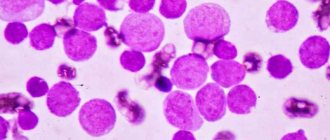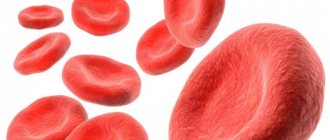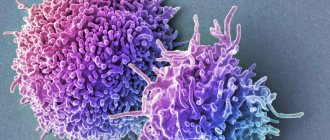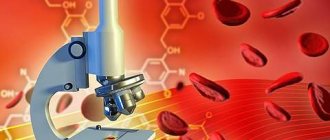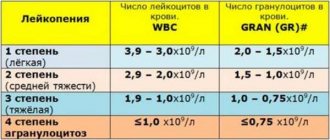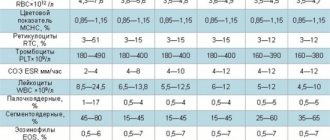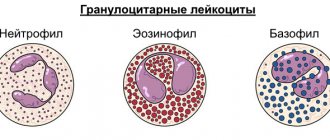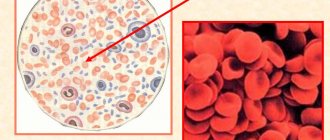Reasons for high and low rates
Any deviations from the norm in lymphocyte counts may indicate pathological processes in the body.
Both high and low lymphocyte counts should be a concern. A high level of lymphocytes is observed in women whose bodies are affected by any viral infection.
In the case of bacterial infection, the number of lymphocytes increases only in tuberculosis and syphilis.
Very often, a high level of lymphocytes is observed when the infection reaches its peak of development.
The doctor should monitor such changes by ordering tests every few days until the patient recovers.
In the event that a woman did not suffer some specific infections in childhood, then when faced with them, her body increases the number of lymphocytes to a significant extent.
Such diseases include rubella, measles, chickenpox, mumps, etc. This increase in the percentage of lymphocytes is associated with the formation of new immune processes.
An increase in the level of lymphocytes is observed when exposed to harmful environmental factors, poisoning with potent chemicals, as well as in case of poisoning by toxins.
In some situations, the growth of lymphocytes causes pathological changes in the body's own cells.
If you suspect a cytological disease, women need to undergo a thorough examination.
A low level of lymphocytes may be associated with a particularly severe infection in the body. Due to the large amount of foreign agent, the lysis of diseased cells occurs too actively, and a significant part of the lymphocytes die.
Video:
At this point, the natural cell replenishment system has not yet had time to restore their normal level. Very often, such indicators appear in the initial stages of diseases.
The level of all protective cells decreases significantly with the development of AIDS, because diseases of this group suppress the immune system. In addition, chronically low lymphocytes are characteristic of patients with tuberculosis.
A decrease in this type of cells is caused by taking certain hormonal drugs and a lack of B vitamins in the body.
If the cause of low lymphocytes is not determined, then the doctor should order a comprehensive study of blood cells to rule out pathologies in this area.
Lymphocytes norm and pathology
Blood consists of cells that are in a liquid solution. In a classic blood test, the number of lymphocytes is presented as a percentage.
This is their relative value. It shows what part of all immune cells is represented by lymphocytes.
Normal relative lymphocyte values depending on age:
We can talk about an increased number of cells if their value is higher than the norm recommended by this laboratory.
Lymphocytes actively increase during stress and infections, with tumors and smoking.
The increase in lymphocyte levels in these different clinical situations is not always the same.
Doctors distinguish the following types of lymphocytosis:
- Absolute;
- Relative.
With the first case, everything is very clear - there are a lot of lymphocytes in quantitative terms. If percentage numbers are converted into absolute numbers, we get a large number of lymphocytes absolutely. Most often, lymphocytosis is absolute.
Norm of lymphocytes in women and men
Clinical studies make it possible to determine both quantitative indicators of lymphocytes and their specific gravity. The norms of this component of leukocytes in the human body change before reaching puberty.
In adult women, their level remains almost unchanged. It is (1.0–4.5) ? 109l or from 19 to 38% of the total number of leukocytes.
The value of the indicator may be influenced by:
- dietary features;
- menstrual cycle;
- the onset of pregnancy;
- blood loss;
- hormonal imbalances.
Lymphocytes in the blood of men should normally be in the range of 26–39%, and in quantitative terms – (1.0–4.5) ? 109l, that is, almost the same as for women.
The norms in this range in healthy men are constant over many years.
Their fluctuations can be caused by:
- stressful situations. Not only negative emotions matter here, but also positive ones. Under any emotional stress, the ratio between neutrophils and lymphocytes changes towards an increase in the latter;
- increased physical activity, which slightly increases the production of lymphocytes. This situation is temporary;
- long-term smoking. The blood test results of heavy smokers differ from those of those who are not addicted to cigarettes. An increase in the level of lymphocytes occurs along with an increase in the number of red blood cells and thickening of the blood.
An increase or decrease in lymphocytes compared to the norm serves as a signal about the presence of diseases in the body.
Norm of lymphocytes in the blood
Since lymphocytes are part of the leukocyte series, a blood test records their percentage of the total number of leukocytes. Sometimes, the designation of the parameter in absolute values is used, i.e. the number of cells per 1 liter of blood.
In addition to gender, age and physiological reasons, the level of lymphocytes can change due to malnutrition, psycho-emotional instability of a person, and unfavorable external influences. For example, lymphocytes and their norm in men working in hazardous chemical production can deviate by more than 15%.
Standard values of lymphocytes in children differ significantly from normal values in adults; in addition, the number of protective cells changes as the child grows older.
The established level of lymphocytes for children has a wider range from 30 to 70%.
Deviations
This index in laboratory testing may deviate from the norm. It can go up or down. This can be caused by any diseases and physiological reasons.
Exceeding level
If a patient has a higher number of lymphocytes than normal, it means he has lymphocytosis, which can be relative or absolute. If in the relative index neutrophils are reduced and lymphocytes are increased, then this is not a pathology. The doctor is based on the absolute cell content.
An increase in the concentration of particles can indicate not only a disease, but also have a physiological nature.
The absolute number of lymphocytes may be increased during colds or menstruation in women.
Important information: Norm of lymphocytes in the blood of children (table by age)
Reasons for increased rates in adults:
- viral liver diseases;
- strict diet;
- reactive immunity;
- menstruation in women;
- tuberculosis;
- syphilis;
- Infectious mononucleosis;
- allergic diseases;
- dysfunction of the thyroid gland;
- arthritis;
- blood cancer;
- endocrine diseases;
- drug poisoning.
Downgrade
A decrease in the concentration of lymphocytes is called lymphopenia. With pneumonia and leukemia, relative lymphopenia is observed. Absolute lymphopenia is less common: with infectious diseases, tuberculosis, sarcoma, immunodeficiency.
Congenital lymphopenia has the following causes:
- poor development of stem cells that produce lymphocytes;
- decreased concentration of T-lymphocytes;
- Wiskott-Aldrich syndrome.
Acquired lymphopenia has causes:
- heart attack;
- diets;
- infectious diseases;
- smoking;
- alcoholism;
- consequences of taking medications;
- systemic pathology that causes allergies to one’s own tissues.
Why and how many lymphocytes does the body need?
Lymphocytes are cellular representatives of white blood and belong to one of five types of leukocytes. These are the main guards and defenders of the body, protecting it from treacherous guests with foreign genes - bacteria, viruses, fungi, parasites, mutated cancer cells. Without lymphocytes, the proper functioning of the immune system is impossible. They are produced in the bone marrow, spleen, thymus gland, and lymph nodes.
The functions of lymphocyte cells depend on the type to which they belong. Three varieties are known (with an increase in lymphocytes in the blood, they are considered as a whole):
- T lymphocytes. This type is endowed with different powers and is divided into T-killers, helpers and suppressors. Killers are involved in the destruction of foreign antigen proteins; T-helpers stimulate the activity of the immune system, the production of antibodies, “calling” both lymphocytes and other types of leukocytes to fight the detected enemy; Suppressors, on the contrary, inhibit the immune response. There are many T cells - 50-70% of the total mass of lymphocytes.
- B lymphocytes. They provide immunity with “memory” - recognizing, remembering foreign antigens and producing immunoglobulins (protein molecules that adhere to a foreign microorganism) to certain types of “enemies”. Content - 8-20% in blood test.
- NK lymphocytes. They are able to recognize atypical (precancerous) and cancer cells, as well as microorganisms that camouflage themselves from T cells (for example, the herpes virus) and destroy them. The level of lymphocytes in the blood, represented by NK cells, is 5-20%.
The number of lymphocytes in the blood, normal:
- For adults (the norm does not differ between men and women), the relative value is 30-40%, the absolute value is 0.8-4x109/liter, i.e. it is worth talking about an increase in the level of lymphocytes in the blood when the number of cells is more than 4 billion per liter;
- for newborns 15-35% or 0.8-9x109/liter;
- for children in the first year of life, the normal level is 45-70% or 0.8-9x109/liter;
- for older children the norm is 30-50% or 0.8-8x109/liter.
What are lymphocytes and how do they work?
Lymphocytes are a group of leukocyte cells that can be divided into 3 types: T, B, NK. Each type has its own functionality, but they all work to solve the same problem: providing immune protection. Of the total number of white blood cells, lymphocytes account for about 30%. Unlike other white cells that die as a result of interaction with a pathogen, lymphocytes can work repeatedly, forming long-term immunity. They will function for several years and at the end of the life cycle they will be destroyed in the spleen.
While no dangerous processes are occurring in the body, the lymphocyte security system is practically at rest. Every day, more than once, it checks all the cells of the body, is the first to detect pathogens and sends information about this to the brain. Only after this is it activated.
Lymphocytes trigger humoral and cellular immunity - a complex system designed by nature to protect the body from pathogens. Large NK-type cells regulate the quality of native cells, destroying abnormal (including tumor) or aged ones. T- and B-type cells destroy foreign elements. They identify infiltrating strangers, separate them into absolute strangers and acquaintances, organize an attack and destroy them, remembering detailed information about pathogens for transmission to other generations (the so-called formation of immunity).
When the level of white lymphocytes is elevated, the process is called lymphocytosis, which in turn can be relative or absolute. In relative terms, the number of all leukocytes remains the same, but the level of lymphocytes is much increased in relation to other leukocyte cells. With absolute, the number of all leukocyte cells is increased, but their internal ratio does not change.
Article on the topic:
What is somatotropic hormone (growth hormone)?
What are lymphocytes
Our blood is red because of red cells or red blood cells. But they have faithful neighbors in the bloodstream - lymphocytes. This is a whole group of cells that have one important common quality: all lymphocytes protect the body.
Among them are:
- B cells.
They know how to turn into a factory for the production of antibodies to any infections. They are considered the main fighters against bacterial diseases. They are formed in the bone marrow. - T cells.
Formed in the thymus and lymph nodes. T lymphocytes are able to effectively resist viral and fungal infections. It is some of the T cells that activate B lymphocytes, sending them a signal about the presence of infection in the blood. - Natural killer cells
. The most mysterious and few of the lymphocytes, NK cells are capable of fighting cancer in its early stages. Killer cells destroy cells that are different from our body, such as those that have turned into tumor cells or are infected with a virus.
Functions of lymphocytes in the human body
Lymphocytes, or lymphocyte agranulocytes, are cells of the immune system that provide immunity to the body. There are several types of lymphoid cells with different functions:
- B cells;
- T cells;
- NK cells.
The body contains the most T-lymphocytes. Their task is to perform the function of regulating immunity, increasing or decreasing the production of antibodies. B species are responsible for recognizing antigens and producing antibodies. NK cells control the quality of existing cells in the body; if necessary, they can destroy degenerated ones - for example, cancerous ones.
T lymphocytes
Normal values of lymphocytes in women of different ages
There is a special table of the norm of lymphocytes in the blood of women after 30, 40, 50 and 60 years of age, which is widely used by doctors to assess the patient’s immune system. It highlights possible deviations to a lesser or greater extent and indicates the main reasons.
In women, the norm of lymphocytes in the blood is determined as a percentage or numerical indicator. It is customary to distinguish between absolute and relative values. The first is characterized by the total number of agranulocytes, the second by the percentage of immune cells among all leukocytes.
For adults, this figure is 30-45% or from 1 to 4.5 * 10 to the 9th power, but according to age and some characteristics of the body, doctors allow a slight deviation from the normal level.
Since every day the female sex experiences various stresses, succumbs to stressful situations, takes medications and undergoes a monthly menstrual cycle.
Normal at 30 years old
In women aged 30, the norm of lymphocytes in the blood is 20-40%. But it is worth understanding that there are some factors that influence the deviation from normal values.
First of all, this age is considered childbearing, therefore, during pregnancy, the expectant mother may experience a decrease in immune cells due to changes in hormonal levels and restructuring of the body. During pregnancy, you should be more careful about your health and undergo regular examinations.
After 40 years
The norm of lymphocytes in the blood of women after 40 years of age remains almost unchanged and also remains within the range of 20-40%. But some changes are possible, because at this age the period of menopause begins, which is characterized by hormonal fluctuations and changes in reproductive function. Taking medications and the presence of certain diseases can also affect the increase.
After 50 years
After 50 years, the norm of lymphocytes in the blood of women from a vein is 18-20%. At this age, menopause begins, changes in hormonal levels begin, and the body is often subject to pathological processes.
The use of medications, individual characteristics and dysfunction of internal organs also have a significant impact on the increase or decrease in agranulocytes.
After 60 years
What is the norm of lymphocytes in the blood of women after 60 years of age? During this period, a healthy body should have 18-20% immune cells. But in old age, the indicators are often characterized by a decrease.
This is due to senile changes, low lymphocyte synthesis and menopause. Often women over 60 years old have a whole bunch of diseases and take medications that also affect immune cells.
Results
Lymphocytes are white blood cells that represent immune white blood cells. Their main functions are to protect the immune system from the invasion of viruses, bacteria, parasites, and the activation of cancer cells. The normal content of lymphocytes in the blood of an adult ranges from 1.1 to 4.5 cells × 10^9/l. This amount corresponds to 19-37% of the total leukocyte mass.
Children's lymphocyte cell values vary depending on the age of the child. Many lymphocytes accumulate in the blood due to infection of the body:
- viruses (flu, herpes, hepatitis, etc.);
- bacteria (tuberculosis, syphilis, etc.);
- helminths and protozoan parasites.
Lymphocytosis in children is most often caused by the development of “childhood” infectious diseases (measles, chickenpox, mononucleosis, etc.). The number of lymphocyte cells is significantly increased in oncological pathologies of the lymphoid and circulatory system (leukemia, lymphosarcoma).
To restore normal blood composition, high-quality treatment of the underlying disease that provoked lymphocytosis is necessary. If the analysis results are persistently unsatisfactory, the patient should undergo additional examination.
Increased lymphocytes in the blood of a child: causes
In a child who was recently born, the level of lymphocytes in the blood is not very high, due to the fact that the child’s immune system does not function at full capacity. But, some time after birth, the number of lymphocytes begins to increase significantly and, until the age of four, the indicator of a particular type of lymphocyte exceeds the number of other groups of leukocytes.
Causes of elevated lymphocytes in the blood in children
To put it simply, an increase or decrease in the level of antibodies in any person is a sign of illness, and we already know that a change in the number of white blood cells is necessary to fight infection or other negative effects on a still small organism. However, a sufficiently high percentage of antibodies in a child does not always mean that the cause is a viral disease, a tumor process, or another bacterial disease. With relative lymphocytosis, the reason for this blood test result may be other factors that reduce the level of the number of completely different types of leukocytes, for example, neutropenia.
In this disease, due to the lack of vitamin B12 in the blood or the use of incorrect medications that suppress the work of the body's defenders - neutrophils.
Causes of elevated lymphocytes in the blood of a child:
- hiv
- chickenpox
- herpes
- measles
- whooping cough
- bacteriological infection
- tuberculosis
- parasitic infestations
The reason for the increase in lymphocytes in the blood of a teenager
The normal level of lymphocytes in a person's blood may vary depending on age. That is why laboratories use different standard norms for children under one year old and ending with teenagers and adults.
The indicators of white cells in adolescents and the older generation also have their own differences. If you take a child 12-16 years old, then at this age the child very often suffers from ARVI or FLU. These are all combined infections, and, as we understand, during adolescence a person and his immune system undergo structural changes, and sometimes it is difficult for the body to cope alone with such a huge content of harmful bacteria.
The most important thing here is not to poison the child with antibiotics, do tests, and start treatment on time, due to the future normalization of the percentage of the level of lymphatic bodies in the blood.
Why does the level of lymphocytes in the blood increase in an infant?
Many infants sometimes experience neutropenia or physiological lymphocytosis. In a child, this imbalance is more noticeable in percentage terms than in others.
The norm is 50-80, so if it is slightly exceeded, it is not at all critical. This condition is relevant not only in adults, but also in many children. Therefore, sometimes your expectations can scare you. The best way to check the status of the level of leukocytes, platelets and lymphocytes is to take blood tests.
There is also a possibility that increased levels of these substances in humans are associated with hereditary diseases acquired in the womb, or with improper formation of the body or lymphatic system at birth.
Lymphocytes and leukocytes: decreased and increased, deciphering the ratio of indicators in the blood
Taking blood and conducting its examination is the first diagnostic procedure for each patient, regardless of what problem and which doctor he consulted.
In some cases, the results obtained show an increase or, conversely, a decrease in one or another indicator, on the basis of which doctors can judge the presence of various malfunctions in the functioning of systems and organs.
In the article you will learn everything about the ratio of lymphocytes and leukocytes, when the levels are low or high in the blood of an adult.
What are lymphocytes and leukocytes and their significance in the blood
Lymphocytes are white blood cells and belong to a subgroup of leukocytes. In general, they are responsible for the functioning of the immune system, its memory and response in the event of penetration of harmful elements.
It is leukocytes that are the first to rush to fight foreign particles when they are detected, but if the other subgroups of this category of cells are engaged in the destruction of harmful elements, then the goal of lymphocytes can be called the destruction of themselves after the fight. Lymphocytes destroy their own cells that have undergone mutation or other damage, as well as those that have degenerated into tumor cells.
Lymphocytes exist in the blood for only a few days, after which they are divided into special subgroups in various glands of the body, each of which has its own functions.
For example, lymph nodes convert about 15% of cells into the category of B lymphocytes, which are one of the most important immune cells. It is they who, when faced with harmful elements, remember them and provide further immunity against these ailments.
In the thymus, approximately 80% of cells are converted into the category of T-lymphocytes, divided into subtypes: T-suppressor, T-heller and T-killer, each of which has its own functions aimed at destroying harmful elements and maintaining the immune system.
NK lymphocytes make up only about 5%, but they are responsible for destroying their own damaged cells. Clusters of dead cells form pus.
In general, all white blood cells play the role of providing the body's natural defenses and maintaining the normal functioning of the immune system.
Norms of lymphocytes and leukocytes in adults and children
lymphocytes can be expressed both in absolute and relative numbers. The norms for this indicator can be considered:
| Age | Relative amount in % | Absolute amount in x109/l |
| From 1 day to 12 months | From 45 to 70 | From 2 to 11 |
| From 1 year to 2 years | From 37 to 60 | From 3.0 to 9.5 |
| From 2 to 4 years | From 33 to 50 | From 2 to 8.0 |
| From 5 to 10 years | From 30 to 50 | From 1.5 to 6.8 |
| From 10 to 16 years | From 30 to 45 | From 1.2 to 5.2 |
| From 16 years and older | From 19 to 37 | From 1.0 to 4.8 |
To determine special lymphocytic subgroups, additional studies can be carried out to assess not only the degree of activity of immune system processes, but also to suspect certain ailments. In the general analysis, only a summary assessment of the level of lymphocytes is performed to facilitate the diagnostic process.
White blood cells represent approximately a third (about 35%) of the total number of lymphocytes . The norms for this parameter depend only on the age of the patient.
| Age | Leukocyte level x109/l |
| In newborns | From 10 to 30 |
| At 1 week | From 9 to 15 |
| In 14 days | From 8.5 to 14 |
| From 1 to 6 months | From 8 to 12 |
| From 6 months to 2 years | From 6.6 to 11.2 |
| From 2 to 4 years | From 5.5 to 15.5 |
| From 4 to 6 years | From 5 to 14.5 |
| From 6 to 10 years | From 4.5 to 13.5 |
| From 10 to 16 years | From 4.5 to 13 |
| From 16 years and older | From 4 to 10 |
Ratio of lymphocytes and leukocytes
The leukocyte formula, or rather, its deviations in any direction, is very important for the diagnosis of many disorders and ailments. Often the total number of leukocytes remains at a normal level, practically unchanged, but other indicators of the leukocyte formula may increase or decrease.
For example, if, with a normal level of leukocytes, an increase in lymphocytes and a decrease in the level of neutrophils is observed, we can conclude that the patient has some kind of viral infection, or has been exposed to radiation, as well as the presence of malignant tumors.
Sometimes a similar phenomenon can occur after taking certain types of medications. In most cases, such a picture in the analysis indicates that the body is trying to fight the disease.
If lymphocytes are elevated, but there is a decrease in neutrophils (another category of leukocytes), then the situation should be interpreted according to age. For children, this phenomenon is considered normal; for adults, it may indicate a disorder. You can read more about the ratio of lymphocytes and neutrophils here.
Lymphocytes are low and leukocytes are high
It is impossible to accurately assess the condition and functioning of the immune system by determining the level of leukocytes alone. In this case, the leukocyte index and the ratio of some parameters of the formula to each other have a more important diagnostic value. More often there are situations when the research results show a decrease in lymphocytes against the background of an increase in leukocytes.
An increase in the number of leukocytes always occurs when any foreign harmful objects enter the body, for example:
- A variety of viruses or bacteria that provoke the development of local purulent reactions or general infectious processes.
- Parasites.
- Substances that cause allergic reactions. In this case, as a rule, eosinophils increase.
- An increase in leukocytes is also observed when food is consumed, which is called the nutritional factor.
A decrease in lymphocytes is called a state of lymphocytopenia, and it represents a problem of quite serious proportions and a reason to consult a doctor. The causes of this condition are often:
- Immunodeficiency of various stages, including AIDS.
- Presence of tumors.
- Taking certain categories of medications, in particular blood poisons or corticosteroids.
- Advanced infection.
- Transferring radical therapies, in particular radiation or chemotherapy.
With a simultaneous decrease in lymphocytes and an increase in the number of leukocytes, the causes of the condition may be:
- The presence of complex infectious processes of a severe form, in particular sepsis or pneumonia.
- The presence of lesions in the blood system, in particular, hematopoietic sprouts.
- Tumor processes.
- Diseases of the autoimmune or endocrine category.
- Various immunodeficiency states, including AIDS, when lymphocytes are constantly destroyed.
Education in the body
The thymus gland (thymus) and lymph nodes are responsible for the formation of these protective cells. The first “controller” produces about 80% of lymphocytes, mainly T-killer cells.
The thymus gland is located behind the upper edge of the sternum:
- The organ stops growing when a person reaches 15 years of age, and its final weight is only 30 grams.
- After this, the thymus gradually atrophies, the functional tissue is replaced by adipose tissue.
- This process is completed by the age of 40, and it is after this that a person becomes vulnerable to many diseases, there is a general decrease in immunity and a tendency to form tumors.
Thus, in old age, the weight of the thymus gland rarely exceeds 6 grams.
Lymph nodes are distributed throughout the body and are responsible for the formation of group B cells. They are synthesized throughout life, so their number practically does not change over time.
What else do blood test results tell you?
When the form with the results falls into our hands, we want to understand all these unfamiliar concepts and find out what is going on in the body even before visiting the doctor. Therefore, we will try to explain what this or that combination of blood elements means.
In a situation where lymphocytes are increased and neutrophils are decreased, we may be talking about the presence of a viral infection; this is also observed due to the side effects of certain medications. A decrease in neutrophils and an increase in lymphocytes at the same time, as a rule, means that a person has a focus of viral damage. You can find out what neutrophils are here.
Neutrophils are reduced and lymphocytes are reduced, with a normal level of eosinophils, which happens when a person gets the influenza virus.
Increased lymphocytes and decreased neutrophils in the blood most often indicate the development of an inflammatory process, which the human immune system is trying to fight on its own. If the content of lymphocytes is too high, tuberculosis or a malfunction of the thyroid gland can be suspected.
If, according to tests, leukocytes are low and lymphocytes are high, the reasons may be hidden in a current viral infection, for example, whooping cough, chickenpox, measles, viral hepatitis, etc., but this combination can occur in a number of other diseases.
If you detect any abnormalities in your blood parameters, you should not panic and invent false diagnoses. The best decision would be to contact a specialist who will explain the current situation and, if necessary, prescribe additional examination or treatment.
Good health!
Lymphocyte count
In the human body, it depends on the age and health of the individual organism. The normal total number of lymphocytes in adults ranges from 20% to 40% percent of the total number of leukocytes; in children, the normal lymphocyte count is from 30% to 50%, and in infants up to one year, 75%.
The total number of lymphocytes is revealed by a clinical blood test. In the analysis, lymphocytes are designated Lymph, LYM, or lym. The analysis indicates the patient's lym and the norm of lymphocytes in the blood. The analysis will show an increase in lym from the norm when:
- the body is affected by a viral infection,
- infected with bacteria
- affected by malignant or benign tumors,
- there is a miliary (pathogen spreads through the circulatory system to all organs) tuberculosis infection,
- surgical intervention took place.
When the level of lymphocytes is determined below normal, the cause may be:
- exposure to ionizing radiation, such as radiation therapy;
- or exposure to chemicals;
- infections: AIDS, purulent processes, sepsis, tuberculosis;
- inherited immunodeficiency diseases;
- treatment with corticosteroids;
- tumors.
NB! Even an experienced doctor often cannot immediately determine the cause of an increase or decrease in leukocyte levels. Additional examinations are needed!
Sometimes, if certain painful conditions are suspected, it is necessary to do a group analysis of lymphocytes.
The lower limit of normal is T-lymphocytes - 65%, B-lymphocytes - 8%, NK-lymphocytes - 9%. The upper limit of normal is T-lymphocytes - 80%, B-lymphocytes - 20%, NK-lymphocytes - 20%. A significant increase in the level of B-leukocytes may be a sign of an autoimmune disease or allergy. A high content of T-lymphocytes with pronounced symptoms of the disease can warn about the transition of the disease to the chronic stage. Leukemia is accompanied by an increase in the absolute number of T-lymphocytes. Too low a percentage of NK lymphocytes prevents implantation of the fertilized egg, and too high a percentage of NK lymphocytes can cause a frozen pregnancy or spontaneous miscarriage.
Each specific case requires careful research. The diagnosis cannot be made solely by abnormal lymphocytes in the blood. The doctor will be able to identify and eliminate the cause only after a series of tests and studies.
Causes of increased lymphocytes
What are the causes of elevated lymphocyte levels in women? In women, an increase in lymphocytes can occur before the onset of menstruation and during pregnancy. Their number is influenced by lifestyle and nutrition. These factors include:
- stress;
- smoking and alcoholism, drug addiction;
- diets and fasting;
- prolonged overeating of foods rich in carbohydrates;
- allergies;
- lack of vitamin B12;
- excessive physical activity.
However, more often the level of lymphocytes is elevated in women due to the presence of pathogens in the body. The number of blood cells increases due to:
- viral diseases: influenza, herpes, hepatitis;
- toxoplasmosis;
- bacterial infections - syphilis, tuberculosis, brucellosis;
- bronchial asthma;
- long-term use of contraceptives;
- lead and arsenic intoxication;
- HIV;
- pathologies of the endocrine system;
- autoimmune diseases;
- for measles, rubella, chickenpox;
- during the development of oncological processes.
Thus, an increase in lymphocytes in women indicates infection of the body with viruses, bacteria, parasites or fungi . Another reason is pathologies of the hematopoietic system, some of which are malignant. During the course of these diseases, immune cells cannot cope with their functions.
Lymphocytosis is divided into reactive and malignant. With a malignant form, white blood cells begin a long battle with cancer cells. To determine the boundary between these concepts, in addition to the OAC, other studies are also prescribed. Distinguishing these conditions sometimes requires complex tests such as determination of lymphocyte subpopulations, chromosomal abnormalities of lymphocyte nuclei, bone marrow examination, and molecular genetic tests.
Article on the topic:
What do elevated platelets in women indicate? Causes, symptoms and treatment
To determine the cause of an increase in lymphocytes, a CBC that simply shows a deviation from the norm will not be enough. It is necessary to conduct additional examination and collect anamnesis. There is no point in looking for the cause on your own, diagnosing yourself, and, especially, self-medicating if the number of lymphocytes is exceeded. A chronic disease that is not detected in time, the symptoms of which will be smoothed out by uncontrolled medication, can end in disaster.
During pregnancy
At the beginning of pregnancy, the mechanism of immune suppression is triggered. This is necessary so that the endometrium of the uterus does not reject an embryo that is foreign to the body at the first stage, which the body initially regards as foreign. The amount of T-suppressors in the blood is increased. By the time of birth and after birth, all data returns to the natural norm.
If the level of lymphocytes in a pregnant woman continues to increase, then complications may develop that threaten miscarriage.
Detailed analysis
To determine the qualitative and quantitative composition of lymphocytes in the blood, a general detailed blood test is prescribed.
On the one hand, this is the simplest and most common test, which almost every person had to take.
On the other hand, it is necessary to properly prepare for the study in order to obtain an informative result.
A detailed general blood test is usually taken in the morning from 7 to 11 o'clock on an empty stomach. It is at this time that blood is drawn in most medical institutions.
Video:
Before the analysis, you must refrain from eating in the morning and a heavy dinner in the evening. A few days before the test, you must stop drinking alcohol and taking strong medications.
It should be noted that the level of lymphocytes does not depend so much on factors such as the patient’s food and physical activity.
However, this type of analysis also contains other indicators. For example, the percentage of neutrophils in the blood can rise even from slight stress. Therefore, it is optimal to prepare properly for the study.
But in emergency situations, if the doctor only needs a lymphocyte formula, then the analysis can be performed at any time of the day, including 2 hours after a meal.
Blood sampling for research can be done either from the patient’s finger or from a vein (depending on the indicators that the attending physician needs to know).
When collecting peripheral blood, the laboratory technician makes a puncture in the area of the ring finger with a special disposable needle.
Puncture of the little finger or thumb is strictly prohibited, because infection in the blood in these places can cause serious harm to the entire palm.
If the patient's skin is too thick or the blood supply to the hand area is not active enough, the healthcare provider may use a special device to automatically puncture.
The needle in such a device makes a deeper puncture. Due to the greater speed of skin puncture, this procedure is less painful, so it is often used when collecting blood from children.
The turnaround time for a complete blood test is several hours. The results of analysis performed in emergency mode may be ready earlier.
Deviations from the norms and their causes
Lymphocytes increase for various reasons, most of which are associated with pathological processes in the body.
Most often, low lymphocytes indicate the presence of a viral infection in the body. It is in the case of such diseases that the number of cells of this type increases.
Other white cells are responsible for fighting bacterial infections. However, in some cases, for example, when the body is infected with syphilis or tuberculosis, the level of lymphocytes can increase, despite the bacterial nature of such diseases.
Video:
Sometimes, a high level of lymphocytes in the blood is a sign that the disease has reached its peak with subsequent recovery.
If the doctor suspects that the concentration of cells is increased precisely for this reason, then a repeat analysis is prescribed after a few days.
The level of lymphocytes rises very strongly if the body is infected with specific infections that a person gets sick with once in a lifetime - rubella, chickenpox, measles, etc.
This is due to the active production of antibodies and training cells to resist this type of infection.
High lymphocyte counts are typical for patients exposed to chemical poisoning, including after an overdose of certain medications.
If the cause of the increase in lymphocytes cannot be determined, then a cytological examination of the cells is prescribed.
Video:
A low level of lymphocytes in the blood may indicate that the cells are not coping with too strong an infection.
Often this result is given by analyzes that were done at a time when most of the cells died and new ones were not yet fully formed.
If such indicators are present, it is recommended to schedule a repeat study in a few days.
In some cases, low lymphocytes may indicate insufficiently efficient activity of one of the organs responsible for the formation of these cells.
A low level of lymphocytes can be observed at the initial stage of any disease. At the moment when the disease reaches its peak, there is a sharp increase in the concentration of cells in the blood.
In the case of diseases that directly affect the human immune system (HIV, tuberculosis), the body’s ability to produce protective cells is reduced.
Therefore, if a doctor prescribes a test, it is necessary to warn him about all the drugs and procedures that the patient uses.
The production of leukocytes of this type is suppressed due to a deficiency of certain vitamins and microelements. The lack of B vitamins is especially acute.
With a deficiency of vitamins of this group, cell division of all types does not occur as actively as the body requires.
It is necessary to closely monitor the composition of your blood and contact your doctor in case of any unexplained changes in test results.
Most serious blood diseases are much easier to treat in the early stages.
Difference Between Leukocytes and Lymphocytes
Leukocytes and lymphocytes are found in the blood of vertebrates.
Leukocytes consist of granulocytes and agranulocytes. Three types of granulocytes are found in the blood. These are neutrophils, eosinophils and basophils. Granulocytes participate in host defense through innate immunity. Lymphocytes are agranulocytes and participate in adaptive immunity by producing specific antibodies to a particular pathogen. Lymphocytes also consist of three types: T lymphocytes, B lymphocytes, and group zero, which contains natural killer cells and cytotoxic cells.
Antigens, which are presented by granulocytes, are identified by T lymphocytes, which activate B lymphocytes to produce specific antibodies.
The main difference between leukocytes and lymphocytes is that leukocytes are all white blood cells in the blood while lymphocytes are one type of blood cell involved in the adaptive immunity of vertebrates .
This article explains
1. What are leukocytes – Characteristics, structure, functions 2. What are lymphocytes – Characteristics, structure, functions 3. What is the difference between leukocytes and lymphocytes
What are leukocytes
Leukocytes are the only type of nucleated cell found in the blood that participate in host defense by destroying pathogens that invade vertebrates. They are usually called leukocytes.
Leukocytes can be divided into two groups depending on the presence of granules in their cytoplasm: granulocytes and agranulocytes. Three types of granulocytes can be found in the blood: neutrophils, eosinophils and basophils. Each of them differs in the shape of the nucleus as well as function in the body. The process of formation of leukocytes is called hematopoiesis.
During hematopoiesis, leukocytes differentiate from the stem cells of myeloblasts, lymphoblasts and monoblasts.
Figure 1: Hematopoiesis
Neutrophils
Neutrophils are professional phagocytes, destroying pathogens like bacteria through phagocytosis. They contain a multipetal nucleus, which usually consists of 2-5 lobes. The diameter of neutrophils is 8.85 microns. Neutrophils are the most common type of white blood cell. 40-75% of leukocytes are neutrophils.
The normal range for eosinophils is 1500-8000 neutrophils per mm-3. The lifespan of neutrophils is 5-90 hours in circulation.
Neutrophil granules contain lysozyme, phospholipase A2, acid hydrolases, myeloperoxidase, elastase, serine proteases, cathepsin G, proteinase 3, proteoglycans, defensins and bacterial permeability protein.
Neutrophils are among the first cells to migrate to an area of inflammation, responding to cytokines released by inflammatory cells. The process of migration of neutrophils to the site of inflammation is called chemotaxis. Activated neutrophils produce neutrophil extracellular traps (NETs).
Eosinophils
Eosinophils provide protection against parasites such as helminths. The nucleus is bilobed in eosinophils. The diameter of eosinophils is 12-17 µm. 1-6% of leukocytes are eosinophils. The normal range for eosinophils is 0-450 eosinophils per mm.
-3, Cytotoxicity is a process that eosinophils provide to protect against common hypersensitivity reactions. Cytotoxicity is mediated by cationic proteins embedded in cytoplasmic granules. The granules contain histamines, RNase, DNase, eosinophil peroxidase, palsminogen, lipase and essential basic proteins.
Basophils and mast cells are also involved in responding to allergic reactions. Eosinophils are also capable of migrating into tissues. Thus, they are found in the thymus, spleen, ovary, uterus, lymph nodes and lower gastrointestinal tract. The lifespan of eosinophils in circulation is 8-12 hours. In tissues it is 8-12 days.
Activation of eosinophils produces cytokines such as TNF-alpha and interleukins, growth factors such as TGF-beta and VEGF, and several other types.
Basophils
Basophils, along with mast cells, produce cytokines against parasites. The nucleus is bean-shaped in basophils. The diameter of basophils is 10-14 microns. Basophils are the least common type of granulocytes in the blood. 0.5-1% of leukocytes are basophils.
The normal range for basophils is 0-300 mm-3. The lifespan of basophils is 60-70 hours. These cytokines provide protection against allergic inflammation.
The granules contain histamine, proteolytic enzymes such as elastase and lysophospholipase, and proteoglycans such as heparin and chondroitin. Histamine and heparin granules prevent blood clotting during circulation.
Basophils also play an important role in defense against viral infections. Leukotrienes and some interleukins are secreted by activated basophils.
Monocytes
Monocytes are the only agranulocytes found in white blood cells other than lymphocytes. They are involved in the intercellular death of pathogens. They have an immediate response before other WBCs enter the infected area.
Migration into inflammatory tissue allows monocytes to differentiate into macrophages, which are a type of professional phagocyte.
Macrophages also present antigens to T lymphocytes, promoting adaptive immune responses.
Another type of white blood cell is lymphocyte, which is described later in the article.
What are lymphocytes
Lymphocytes are the final type of white blood cell primarily involved in adaptive immunity, producing specific antibodies to a particular pathogen during host defense.
During hematopoiesis, lymphocytes differentiate from lymphoblastic stem cells. The three main types of lymphocytes are T lymphocytes, B lymphocytes, and natural killer cells.
T lymphocytes participate in humoral immunity, and differentiated plasma cells from B lymphocytes secrete specific antibodies to a particular pathogen.
mature T lymphocytes express T cell receptors (TcRs) that are specific for a particular antigen. CD3 molecules are expressed on the membrane by binding to TcR.
one type of accessory molecule, either CD4 or CD8, is also expressed on the T cell membrane. TcR/CD3 is capable of identifying antigens presented in the MHC complex on infected cells.
There are three types of T cells: T helper cells, T cytotoxic cells and T suppressor cells. T helper cells act on B lymphocytes, activating them to produce specific antigens for a particular pathogen.
T-cytotoxic cells are cytotoxic to tumor cells while presenting pathogen antigens along with MHC class I molecules. T-B cell responses are suppressed by T-suppressor cells.
Figure 2: T cell activation of B cells
B lymphocytes Activated by T cells and antibodies, IgM is produced as a primary immunization, which can be identified in the blood serum 3-5 days after infection. IgM levels peak 10 days after infection.
B cells also present split pathogen antigens along with MHC II complexes. Some B cells become memory B cells, retaining memories of invading pathogens for long periods of time.
Natural killer (NK) cells are granular lymphocytes that nonspecifically phagocytose infected cells with viruses and tumor cells. Digestion of these cells by NK cells secretes IFN-gamma and IL-2.
NK cells express the surface receptor CD16. Activated NK cells also secrete INF-alpha and TNF-gamma.
Figure 3: Natural killer cell
correlation
Leukocytes: Leukocytes refer to all the white blood cells in the blood.
Lymphocytes: Lymphocytes are one type of white blood cell in the blood primarily involved in adaptive immunity during host defense.
Compound
Leukocytes: Leukocytes consist of granulocytes and agranulocytes.
Lymphocytes: Lymphocytes mainly consist of agranulocytes only.
Types
Leukocytes: Leukocytes consist of neutrophils, eosinophils, basophils and lymphocytes.
Lymphocytes: Lymphocytes consist of T lymphocytes, B lymphocytes and group zero containing natural killer cells and cytotoxic cells.
production
Leukocytes: Leukocytes are produced either in myeloid stem cells or lymphoid progenitor cells.
Lymphocytes: Lymphocytes are produced in lymphoid progenitor cells.
Role in host defense
Leukocytes: Leukocytes are involved in both innate and adaptive immunity during host defense.
Lymphocytes: Lymphocytes are mainly involved in adaptive immunity during host defense.
Conclusion
White blood cells are white blood cells found in the blood. Five main types of white blood cells are found in the blood. These are neutrophils, eosinophils, basophils, monocytes and lymphocytes. Neutrophils, eosinophils and basophils are granulocytes containing different contents in their granules.
They are mainly involved in innate immunity, where the host defense system generates the same immune response nonspecifically to all pathogens. These granulocytes destroy pathogens such as bacteria, viruses and parasites through pagocytosis.
While destroying pathogens, they present the antigens of these destroyed pathogens on their cell membrane. Monocytes are a type of white blood cell that lack granules. But monocytes serve as professional phagocytes, differentiating into macrophages within inflammatory tissues.
The resulting antigens are recognized by helper T cells, allowing B cells to generate specific antibodies for a particular antigen. Therefore, lymphocytes participate in the adaptive immunity of host defense mechanisms.
Natural killer cells are a type of circulating lymphocyte that phagocytose virus-infected cells and tumor cells. This is a type of granulocyte. However, the main difference between white blood cells and lymphocytes is the type of immunity they generate during host defense.
Reference: 1. Goldman, Armond S. “Review of Immunology.” Medical microbiology. 4th edition. US National Library of Medicine, January 01, 1996. Web. April 05, 2020
Image credit: 1. "Illu Blood Cell Line" (Public Domain) via
Source: https://ru.strephonsays.com/difference-between-leukocytes-and-lymphocytes

